module 2 unit1 what did she have for lunch
五年级下册英语课文对话(全册)

五年级英语下册Module lUnit 1 We lived in a small house.1.Look, listen and say. Lingling: Look, there are two beautiful cats on the chair. Sam: There is only one now. Lingling: Well, there were two.2 Listen, read and act out. Lingling is still in the UK with Sam and Amy.Amy:Look, Lingling! It’s a programme about China. Come and watch!Lingling: I’m coming!Old lady: Life was very different in China many years ago. Interviewer: How was it different? Old lady:We lived in a small house. We didn’t have enough foo d. There weren’t many buses. There weren’t any televisions.Interviewer: How about now? Old lady:We live in a big house. We’ve got lots of food. There are lots of buses and cars. I watch TV every day. Yesterday I watched TV with my grandchildren. Interviewer: Thank you for talking to us.Amy: China is changing. Lingling: I miss China! I miss my grandma!Unit 2 She didn’t have atelevision.1 Look, listen and say.Amy: He has got strong legs. He can jump really far.Tom: But he didn’t have any legs then.2.Listen and read.Dear Daming,I watched a television programme about China last night. An old ladytalked about her life many years ago. She worked in the fields. She cooked on a fire. She didn’t have a television or a radio. She didn’t have a telephone. S he couldn’t read or write. I miss my grandma.I miss you too!I hope you are well.Love,LinglingModule 2Unit 1 She learnt English.1 Listen and chant.She learnt to dance.She learnt to cook.She taught languagesand wrote a book.2 Listen, read and act out. Sam: Who are they, Lingling? Lingling:They’re my grandparents.Sam:Who’s this?Lingling:It’s my grandma. She was a dancer. She danced in lots of Chinese cities.Amy: Did she learn any foreign languages?Lingling: Yes, she learnt English. Amy: Is this your grandpa? Lingling: Yes, it is. He was a driver.Amy: Did he learn English too? Lingling: No, he didn’t. But he’s learning English now!Unit 2 Mr Li was a teacher.1 Listen and chant.Li Wei was six then.He liked going to school.He learnt Maths and Science,and Art and Chinese too.Li Wei is thirty now.He likes working at school.He teaches Maths and Science,and Art and Chinese too.2 Listen and read.Twenty years ago, Mr Li was a teacher. He taught Chinese. Chen Hai was in his class. He was a good pupil. He studied very hard. Now Mr Li doesn’t work. He’s learning English. Chen Hai is an English teacher . He’s teaching Mr Li.Module 3Unit 1 She had eggs andsausages.1 Listen and chant.What did you have for dinner? Bread, meat and a hamburger. What did you have for dinner? Fish , eggs and a hamburger.2 Listen , read and act out. Daming:Look ! I’ve got an email from Lingling. It’s about English food. Fanfan: What does it say? Daming:Yesterday she had an English breakfast.Fanfan: What did she have? Daming:She had eggs and sausages.Fanfan:And what did she have for lunch?Daming: She had sandwiches. Fanfan:what did she have for dinner?Daming: She had fish and chips. Fanfan: Fish and chips? Daming:Yes. It’s a traditional English dish.Fanfan:Does Lingling like English food?Daming: Yes, she does. She says it’s delicious!Unit 2 Sam ate fourhamburgers.1 Look, listen and say.He ate all the fish and he ate all the meat.So he has got no food now.2 Listen and read.Dear daming,Today Sam ate four hamburgers at school ! He likes hamburgers very much. Lingling had a sandwich because she doesn’t like hamburgers. She gave her hamburgers to Sam.I miss Chinese food. Tonight Mum is going to cook Chinese food for us.Love,AmyModule 4Unit 1 Let’s make a homelibrary.1 Look, listen and say.We’ve got books for teachers. We’ve got books for students. Sorry, we haven’t got books for you.Woof! Woof!2 Listen, read and act out.Ms Smart: A friend sent these books and CDS to us. Let’s make a home library.Lingling: That’s a good idea. Amy:These are all books about science.Lingling:Let’s put them on this shell.Amy:Here you are . Let’s put them with the CDs.Lingling: OK.Amy:What are these big books?They’re heavy.Lingling:They’re dictionaries. We can put them here.Amy:These are the library cards for our friends.Lingling: Great! Now we can ask them to come.Sam:Where are the books about sports, please?Lingling: They are on Shelf C. Sam:No, they aren’t. These books are about art.Lingling: What? Oh, they’re in the wrong place.John:Where are the books about animals.Lingling: They are on Shelf B. John:I can’t find them. The books on Shelf B are about computers. Lingling: Oh, dear!Unit 2 We can find information from books and CDs .1 Look, listen and say.I want a Chinese book. Where can I find it?I want a Maths book. Where can I find it?I want an English book. Where can I find it?They’re all here. They’re e-books.2 Listen and read.We are going to do a science project about animals. This is a guide for us to get information from the school library. We can find information from books and CDs. We can find information from films and e-books as well. There are lots of different ways to find information on this topic.Module5Unit 1 It’s big and light.1 Listen and chant.It’s big. It’s light.It’s hard to fly a kite.It’s blue. It’s white.It’s nice to ride a bike.2 Listen, read and act out.Ms Smart: Lingling, look at your bag! It’s broken. You can’t take i t to China. I’ll buy you a new one. Lingling: Thank you.At the Department Store Lingling: This black bag is nice. It’s big!Ms Smart: But it’s heavy. This green one is light. And it’s got two pockets. You can put your umbrella there.Lingling: But it’s sm all.Ms Smart: Look at this blue one. It’s big and light.Lingling: Oh yes!Sales assistant:And it’s got four wheels. It’ll be easy for you to carry.Ms Smart: Great! We’ll take it. Lingling: Thank you very much.Unit 2 It’s too big for you.1 Look, listen and say.Look! My new hat. It’s too big for you. It’s too big for you too.It’s nice for me.2 Listen and read.Amy :Look at this blue T-shirt. It’s nice.LIngling: It has got a panda on it. Amy:But it’s too big for you! Lingling:Have you got a small one, please?Sales assistant:Try this white one.Amy:That’s lovely! You can take it to ChinaModule 6Unit 1 I went there last year . ❶Look, listen and say.Where did you go for the holidays?I went to the moon.The moon? How did you get there?I used my computer. Ha ha...❷Listen, read and act out.Amy : Mum ,look .Lingling has got some interesting photos .Ms Smart : Can I see them , Lingling .Lingling : Of course .Lingling : They are photos of me and my family in China . This is Xiaojiang. It’s in the west of China.I went there last year .Amy : Did you go with your parents?Lingling: Yes ,I did .We stayed with my grandma for a weekin July .Ms Smart : The mountains are really beautiful .Lingling : This is Hainan .It’s inthe south of China .Amy : Who is this ?Lingling:It’s my uncle .He lives there with his three children .My cousins visit Beijingevery year .Ms Smart : Oh ,yes , I remember !I met them in June !They’re Li people.Unit 2She visited the Tianchi Lake . ❶Listen and chant.East and west,home is the best.North and south,Let’s have a rest.❷Listen and read.In July ,Lingling went to Xinjiang with her parents .Xinjiang is in the west of China .She rode a horse . She climbed the Tianshan Mountain . She visited the Tianchi Lake .It was very beautiful .She had a lovely time there .Module 7Unit 1 My father goes to work at eight o’clock every morning.❶Look, listen and say.Amy: Dad,will you take us to the park tomorrow morning?Mr Smart:Yes. I’ll take you there at half past seven .Amy: Half past seven?Mr Smart: Half past seven.❷Listen, read and act out. Daming:My father goes to work at eight o’clock every morning.Fangfang: What does he do? Daming: He’s a policeman.Fangfang: My father goes to work at six o’clock every evening. Daming: That’s late. What does he do?Fangfang: He’s a worker in factory .Daming: My mother goes to work at eleven o’clock every night. Fangfang: That’s very , very late. What does she do?Daming: She’s a nurse .Fangfang: My mother goes to work at half past five every morning.Daming: That’s very early. What does she do?Fangfang: She’s a taxi driver.Fangfang: Look! Here’s my mother !Fangfang’s mother: Hello, children. I’ll take you to sch ool. Fangfang and Daming: Thank you!Unit 2 I ’ll be home at seveno’clock .❶Look, listen and say.Oh no !It’s a quarter to eight now. School stater at eight o’clock .I’ll be late.It’s half past eight now.I’m late and I’m tired.❷Listen and read.Sam: Dad ,it six o’clock now . Will you be home at seven o’clock ?Mr Smart: Yes , I will. Sam: It’s half past six. Are you going to be late, Dad?Mr Smart: Don’t worry! I’ll be home at seven o’clock.Mr Smart: It’s a quarter to seven . What time will you be home?Mr Smart: I’ll be home at seven o’clock.Sam: It’s seven o’clock.Here he is.All: Happy birthday!Mr Smart: Thank you !Module 8Unit 1 Will you help me ? ❶Look, listen and say. Tomorrow is my cat’s birthday.I’ ll make a paper fish for he r.It will be a great present.❷Listen, read and act out. Daming:I’m going to visit mycousin in New York.His name is Simon.What present can I take? Fangfang: What about a toy panda?Daming: I think he’s got a toy panda .His mother and grandma are Chinese.Fangfang: What about a kite? Daming: Good idea! I’ll made a kite.Fangfang: But will it be windy in New York?Daming: I think so.Daming: Will you help me ? Fangfang: Of course I will. Fangfang: Daming, your cousin will love this kite .It ‘s a Chine se dragon. Daming: Thank you for you help. It will be a great present. Fangfang: You can write the Chinese word for “ dragon” on it . Daming: That’s great idea!Unit 2 I made a kite.❶Listen and chant.I drew a dragon.I cut the paper.I made a kite.for my sister.❷Listen and read.I made a kiteI drew a dragon on a piece of yellow paper.I painted it .I cut the paper.I put sticks on it .I tied strings to it .Then I could fly my kite.Module 9Unit 1 We laughed a lot .❶Look, listen and say.Amy: I saw a dog . It wore a coat. Sam: I saw a dog . It wore a hat. Lingling: I saw a man . It wore a skirt.❷Listen and read.Daming:Wow!I’ve got two letters in English ! One is from UK and one is from the US.15MarlingStreetLondon , NW2UK Dear Daming ,Last week we went to a children’s theatre.The men wore women’s clothes .The women wore men’sclothes .The actors told lots ofjokes . It was very funny .We laughed a lot. Children here love the theatre .After the show we went to a restaurant .We all ate hamburgers a nd chips .Are you ready for your trip to America ?Love,Lingling.Unit 2Mum bought new T-shirtsfor you .❶Listen and chant.He borrowed some books.And he read them all.He bought some books.But he didn’t read them all.❷Listen and read.Dear Daming ,How are you ?We are going to see you in three weeks .Dad’s going toput another bed in my room.Mum bought new T-shirts for you . Dad read a book about Chinesehistory .He is going to ask you some questions .And we borrowed a bike for you .Don’t forget to bring CDs of Chinese songs .We can listen to them in the evenings.See you soon !SimonModule 10Unit 1 Where are you going ? ❶Look, listen and say.Ms Smart:Where are you going this weekend , Sam?Sam: I don’t know.Ms Smart: When are you going to get up?Sam: I don’t know!Sam: Mum, what did you say to me ?Ms Smart: I don’t know!❷Listen, read and act out. Grandma : Hello ,Daming . Daming : Hello ,Grandma . Grandma : Are you ready for your trip tomorrow ? Daming:I think so.But I feel nervous . Grandma: It will be all right . I’m going to meet youin New York .Grandma: You can makea list of things to do .Daming : That’s a good idea . Grandma: Where are you going ? Daming : To the airport . Grandma : What are you going to take ?Daming: Clothes, shoes, presents, the ticket, my passport …Grandma : When are you goingto go to the airport ?Daming : At seven o’clock tomorrow morning .Grandm a : Who’s going tothe airport with you ?Daming : Who ? Mum! Grandma: Great! Safe trip, Daming!Unit 2 I’m in New York now .❶Look, listen and say.This is my new pet .It speaks English.Hello! Hello!Nihao! Nihao !Wow! It speaks Chinese too.❷Listen and read.Dear Mum and Dad ,I’m in New York now .I arrived here yesterday .I’m very happy.Grandmaand Cousin Simon met me at the airport .We took a yellow taxi to their home.New York is very beautiful . There are lots of tall buildings, cars and people .Grandma made Chinese food for me .But I want to try American food . I want to find out more about the US.I will write again soon .LoveDaming。
春外研版(一起)五下Module 2 Unit 1《What did she have for lunch》word教案2
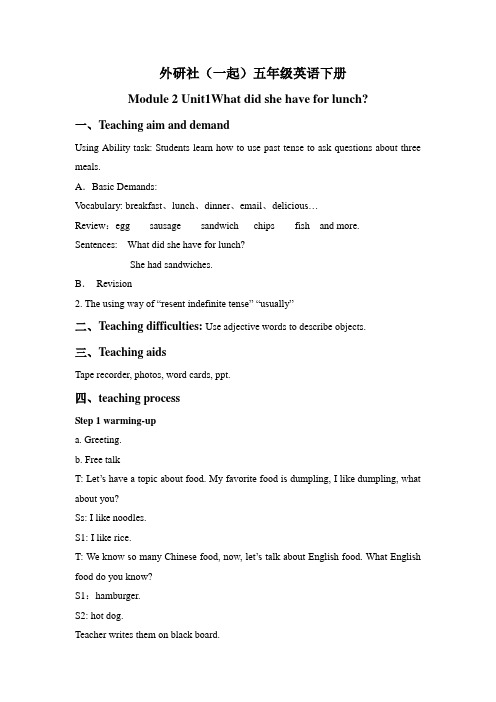
外研社(一起)五年级英语下册Module 2 Unit1What did she have for lunch?一、Teaching aim and demandUsing Ability task: Students learn how to use past tense to ask questions about three meals.A.Basic Demands:V ocabulary: breakfast、lunch、dinner、email、delicious…Review:egg sausage sandwich chips fish and more. Sentences: What did she have for lunch?She had sandwiches.B.Revision2. The using way of “resent indefinite tense” “usually”二、Teaching difficulties: Use adjective words to describe objects.三、Teaching aidsTape recorder, photos, word cards, ppt.四、teaching processStep 1 warming-upa. Greeting.b. Free talkT: Let’s have a topic about food. My favorite food is dumpling, I like dumpling, what about you?Ss: I like noodles.S1: I like rice.T: We know so many Chinese food, now, let’s talk about English food. What English food do you know?S1:hamburger.S2: hot dog.Teacher writes them on black board.(1)Match game about compare Chinese food or English food.(2) Show PPT about some foods and to review the words:(breakfast lunch dinner egg sausage sandwich fish chip…)Step 2 Presentation(1) Before the lesson T will ask the Ss: “What’s your favorite food?” In this part Ss should try to remember the foods word. Let’s compete i n each group.(2) T: Do you know any traditional food in England? Yesterday our friend Lingling had a lot of English food, let’s see what are they?Step 3 Practice (asks and answers in small group)(1) What did she have for breakfast?She had eggs and sausages.(2) What did she have for dinner?She had fish and chips.Step 4 Listen and Read.(1) Listen to the cassette and point.(2) Listen and repeat then T will explain some words and important sentences for Ss. Step 5 Homework(1) Listen and read the text 3 times.(2)Write the new words. (5words)(3)Draw a picture about your meals: (some Ss had better to write the sentences by themselves…)Module 2 Unit1What did she have for lunch? 第二课时一、Teaching aim:Using simple past tense to ask about eating habit.二、Teaching content:1.新词汇中清浊辅音的发音需强化,便于单词的记忆。
外研版小学英语(新标准一起)五年级下册全册教案
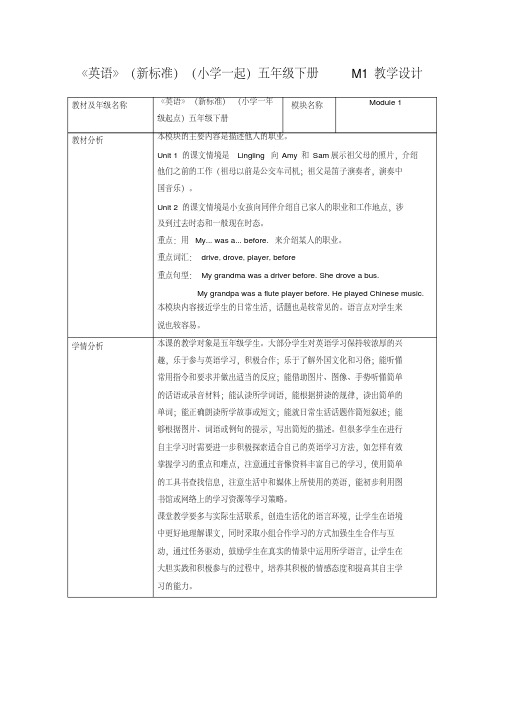
《英语》(新标准)(小学一起)五年级下册M1教学设计模块名称Module 1教材及年级名称《英语》(新标准)(小学一年级起点)五年级下册教材分析本模块的主要内容是描述他人的职业。
Unit 1的课文情境是Lingling向Amy和Sam展示祖父母的照片,介绍他们之前的工作(祖母以前是公交车司机;祖父是笛子演奏者,演奏中国音乐)。
Unit 2的课文情境是小女孩向同伴介绍自己家人的职业和工作地点,涉及到过去时态和一般现在时态。
重点:用My... was a... before. 来介绍某人的职业。
重点词汇:drive, drove, player, before重点句型:My grandma was a driver before. She drove a bus.My grandpa was a flute player before. He played Chinese music.本模块内容接近学生的日常生活,话题也是较常见的。
语言点对学生来说也较容易。
学情分析本课的教学对象是五年级学生。
大部分学生对英语学习保持较浓厚的兴趣,乐于参与英语学习,积极合作;乐于了解外国文化和习俗;能听懂常用指令和要求并做出适当的反应;能借助图片、图像、手势听懂简单的话语或录音材料;能认读所学词语,能根据拼读的规律,读出简单的单词;能正确朗读所学故事或短文;能就日常生活话题作简短叙述;能够根据图片、词语或例句的提示,写出简短的描述。
但很多学生在进行自主学习时需要进一步积极探索适合自己的英语学习方法,如怎样有效掌握学习的重点和难点,注意通过音像资料丰富自己的学习,使用简单的工具书查找信息,注意生活中和媒体上所使用的英语,能初步利用图书馆或网络上的学习资源等学习策略。
课堂教学要多与实际生活联系,创造生活化的语言环境,让学生在语境中更好地理解课文,同时采取小组合作学习的方式加强生生合作与互动,通过任务驱动,鼓励学生在真实的情景中运用所学语言,让学生在大胆实践和积极参与的过程中,培养其积极的情感态度和提高其自主学习的能力。
五年级下册英语说课稿-Module 2 Unit 1《What did she have for l

五年级下册英语说课稿 - Module 2 Unit 1《What did she havefor lunch》| 外研社(一起)一、教学背景•适用年级:五年级•教材版本:外研社(一起)五年级下册英语•单元主题:Food and drink(食物和饮料)•单元名称:Module 2 Unit 1《What did she have for lunch》(她午餐吃了什么)•授课时间:40分钟二、教学目标1. 知识目标•能听、说、认读并理解单词:cake、bread、juice、fruit、noodles、rice。
•能够用简单的英语问别人吃了什么,以及用简单的英语回答自己吃了什么。
2. 能力目标•能够流畅地进行简单的英语对话,表达自己的思想和意见。
•能够用英语描述自己和别人的午餐内容。
3. 情感目标•培养学生良好的饮食习惯和健康意识。
•培养学生合作意识和团队精神。
三、教学重点•能听、说、认读并理解单词:cake、bread、juice、fruit、noodles、rice。
•能够用简单的英语问别人吃了什么,以及用简单的英语回答自己吃了什么。
四、教学难点•能够用英语描述自己和别人的午餐内容。
•能够流畅地进行简单的英语对话,表达自己的思想和意见。
五、教学过程1. warming up•讲师以图片或实物为例,向学生介绍几种通常的午餐食物,引导学生说出自己通常吃的午餐。
•引导学生思考和讨论,健康的饮食习惯对身体的重要性。
2. presentation•引导学生认读单词:cake、bread、juice、fruit、noodles、rice。
•向学生展示图片或实物,并模仿读出单词。
•引导学生回答问题,以巩固新学单词的理解和应用。
3. practice•分组让学生进行角色扮演,模拟英语对话问答自己和别人午餐的内容。
•部分学生在教室中展示他们刚才表演的对话。
4. production•引导学生合作完成任务,描述自己和朋友所吃的午餐内容。
五年级下册英语教案-Module2 Unit1 What did she have for lunc

五年级下册英语教案-Module2 Unit1 What Did She Have forLunch | 外研社(一起)一、教学目标1.能理解八种不同食品的单词。
2.能说出不同人吃过的食品。
3.能运用正确的语法结构说出过去式和疑问句。
二、教学重点1.单词:apple, banana, sandwich, soup, salad, pizza, egg, chicken。
2.语法:过去式 did + eat/drink,疑问句 What did + 主语 + eat/drink?三、教学准备教材:外研社(一起)五年级下册英语教材 Module 2 Unit 1。
教具:教育卡片,单词卡片,PPT,课件,实物食物。
四、教学过程1. 导入新课通过展示一组实物食物,引导学生回忆上一课所学的词汇,如: bread, cereal。
2. 新授单词给学生出示一个单词卡片,音频提示单词后,学生大声跟读。
教师模仿动词eat/drink 在白板上写下,再示范和要求学生说出 I/you/he/she/they eat/drink。
教学重点单词:1.apple 苹果2.banana 香蕉3.sandwich 三明治4.soup 汤5.salad 沙拉6.pizza 披萨7.egg 鸡蛋8.chicken 鸡肉3. 语法教学过去式教师在白板上写下 did,然后写下单词 eat/drink。
带领学生重复出声,并造句:例如:•I ate an apple.•She drank soup.疑问句 What did she/he/they eat?教师在白板上列出主语:I, you, he, she, they,并教授what did的用法。
教师想出舌后,举手然后向学生调动。
为了助长孩子的发言欲,如何怒放孩子的语言才是一个好老师应该具备的素质。
例如:•what did you eat for breakfast?•what did he eat for lunch4. 练习教师出示多幅音频和图片,在PPT上放置多达10种不同的食物图片,播放录音,让学生跟读句子并回答问题。
五年级下册英语教学设计-Module2Unit 1 What did she have for lu

五年级下册英语教学设计-Module2Unit 1 What did she havefor lunch (2) 外研版(一起)一、教学目标1.学习新词汇:sandwiches, grapes, banana, hamburger, orange juice, chicken。
2.通过写作和口语练习巩固现在完成时态的用法。
3.能够用正确的语法和词汇描述他人的午餐食物。
4.通过听、说、读、写的综合活动培养学生的英语语言技能。
二、教学重点和难点教学重点:1.学生通过学习新词汇,巩固现在完成时态的用法。
2.能够用正确的语法和词汇描述他人的午餐食物。
教学难点:1.学生在实际交流中运用已学知识。
2.理解现在完成时态的概念和用法。
三、教学准备1.多媒体课件,包含有关新词汇图片、动画和声音。
2.白板、白板笔和橡皮擦。
3.课堂活动练习材料,包括练习册和作业本。
四、教学过程时间教学过程教学方法5min1. 导入新课程,介绍学习目标和重点问答教学法2. 师生互动,了解学生在上课中的经验和感受讨论和分享10 min 3. 新词汇学习1:呈现新单词和图片,教授单词的发音、拼写和意思,并运用多媒体播放[1]演示和讲解,多媒体教学法15min4. 完成课堂活动练习1和练习2,巩固新词汇课堂活动10 5. 现在完成时态的引入:呈现新单词和图片,并引出演示和讲解,多min句子及其构成,学生模仿运用媒体教学法20 min 6. 完成课堂活动练习3,巩固现在完成时态的用法和构成课堂活动10 min 7. 能力提升:要求学生描述他人的午餐食物,教师给出范例及提示问答教学法,多媒体教学法20 min 8. 完成课堂活动练习4,让学生在小组内互相练习描述他人的午餐食物小组合作和交流10 min9. 课程总结:对今天的课程进行总结,回答学生的问题,预告下节课内容问答教学法五、作业布置1.完成练习册上的习题。
2.准备口语展示,描述自己和家人的午餐食物。
小学英语外研版五年级下册模块知识点
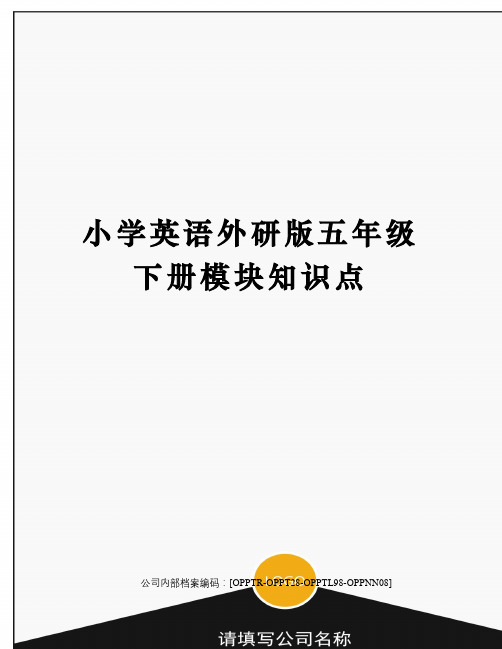
小学英语外研版五年级下册模块知识点公司内部档案编码:[OPPTR-OPPT28-OPPTL98-OPPNN08]Module 1 Unit 1重点句子:1.She was young in this picture.她在这张照片里很年轻.否定句:She wasn’t young in this picture.一般疑问句:Was she young in this picture2. She was a driver before.她以前是一个司机.否定句:She wasn’t a driver before.一般疑问句:Was she a driver before肯定回答:Yes, she was. / No, she wasn’t.就划线部分提问:What was she before3.He played Chinese music.他演奏中国音乐.否定句:He didn’t play Chinese music.一般疑问句:Did he play Chinese music肯定回答:Yes, he did. / No, he didn’t.就划线部分提问:What music did he play4.I can play the flute, too. = I can also play the flute.我也会演奏笛子.5. She drove a bus.她开公共汽车.就划线部分提问:What did she drive6. He teaches us English.他教我们英语.就划线部分提问:What does he teach us7. She helped children.她帮助了孩子们.就划线部分提问:What did she do重点单词:1. grandma2. picture祖母,奶奶图片,照片3. player 玩家,演奏者,运动员,演员Module 1 Unit 2重点句子:1.My grandpa worked in an office.他在办公室工作.否定句:My grandpa didn’t work in an office.一般疑问句:Did your grandpa work in an office肯定回答:Yes, he did. / No, he didn’t.就划线部分提问:Where did your grandpa work2.My mother works in a hospital.我(de)妈妈在医院上班.否定句:My mother doesn’t work in a hospital.一般疑问句:Does your mother work in a hospital 肯定回答:Yes, she does. / No, she doesn’t.就划线部分提问:Where does your mother work3.My parents work in a factory否定句:My parents don’t work in a factory.一般疑问句:Do your parents work in a factory肯定回答:Yes, they do. / No, they don’t.就划线部分提问:Where do your parents work4.There were no computers like there are today.过去不像今天这样,有电脑.5. I was a teacher before.就划线部分提问:What were you before重点单词和短语:1. office2. factory3. hospital办公室工厂医院4. parents 6. shop 7. in the sun父母商店在阳光下very hard工作非常努力Module 2 Unit 1重点句子:1.I’ve got an email from Lingling. 我收到玲玲发(de)一封电子邮件.2.It’s about English food. 它是关于英国食物(de).3.Yesterday she had an English breakfast. 昨天她吃了一顿英国式早餐.4.She had eggs and sausages for breakfast. 她早餐吃了鸡蛋和香肠.否定句:She didn’t have eggs and sausages.一般疑问句:Did she have eggs and sausages肯定回答:Yes, she did. / No, she didn’t.就划线部分提问:What did she have for breakfast5.It’s a traditional English dinner. 它是一顿传统(de)英国式晚餐.6.She says it’s delicious.否定句:She doesn’t say it’s delicious.一般疑问句:Does she say it’s delicious肯定回答:Yes, she does. / No, she doesn’t.就划线部分提问:What does she say重点单词:1. email2. food3. breakfast4. lunch电子邮件食物(不可数)早餐午餐5. dinner6. sausages7. sandwiches8. chips晚餐香肠三明治薯条9. traditional 10. delicious 11. different传统(de)好吃(de)不同(de)Module 2 Unit 2重点句子:1.English people usually have breakfast at seven o’clock. 英国人通常在7点钟吃早餐.就划线部分提问:What time do English people usually have breakfast2.Sundays are special in England. 在英国每周日是很特别(de).3.Families usually eat lunch together. 家人们通常一起吃午餐.4.They eat chicken, potatoes and vegetables. 他们吃鸡肉,土豆和蔬菜.5.On Fridays, many people eat fish. 在每个周五,许多人吃鱼.6.He has dinner at half past twelve.就划线部分提问:What time does he have dinner7.She has biscuits and noodles.What did she have重点单词:1. England2. usually3. special4. families英国通常特别(de) family(de)复数5. together6. chicken7. potatoes8. vegetable一起鸡,鸡肉 potato(de)负数蔬菜9. want to do sth.想要做某事.10.food食物/ meat肉/ fish鱼肉/ chicken鸡肉这几个词都是不可数名词.Module 3 Unit 1Wordsreturn 归还 computer计算机,电脑 like 喜欢card 卡片,名片 week 星期,周video 录像,视频 shelf架子library 图书馆favourite 特别喜欢(de) return 归还Phrasein China 在中国 on the computer 在电脑上at the library 在图书馆in two weeks 在两周内 library card 借书卡 on shelf 在书架上lend…to… 把…借给…borrow…from… 从…借入本课语法点1. have got/haven’t gothave got是表示“有”(de)意思;什么时候用have got,什么时候用has got 取决于主语,如果主语是第三人称单数,就用has got,其它(de)就用have got.如果要对have/has got表示否定,只须在have/has后加上not即可,have not可以缩写成haven’t;has not可以缩写成hasn‘t.2.Have…got /Yes/NoHave got(de)—般疑问句是: Have/Has sb got…如: Have you got a sandwich你有一块三明治吗具体是用have还是用has就由sb(de)人称决定. Have you got…是—般疑问句,回答要用yes和no.Module 3 Unit 2Wordsborrow 借入;借来zoo动物园 wear 穿着bookshop 书店 school 学校 talk 谈话,讲话hear 听说,听到park 公园 friend 朋友type n.类型,品种 v.打字Phraselots of 很多,大量 talk to sb. 对某人说话use the computer 使用电脑 borrow books借书do your homework 做你(de)家庭作业English libraries 英国(de)图书馆in a library 在一个图书馆 so much 如此多talk to your friends 和你(de)朋友们交谈lots of stories 很多故事本课语法点1. can/can’tcan是情态动词,这里表示“能,会”(de)意思,用来表示能力,后面接上动词原形,这一点同学们要记住哦.情态动词“can“可以用来表示“会……”,can‘t表示“不会……”(de)意思.2. 学习部分介词(de)用法with是介词,可以表示“用”(de)意思;with还有“和…一起”(de)意思.with后面可以加工具类(de)名词,例如:Cut it with a knife.(用刀切开它.)工具、器具、材料类(de)名词都和with这个介词搭配,表示“用(某种工具)……”.介词for后面接某人,表示动作(de)对象或者接受者,意思是“给……”、“对……(而言)”.当我们表达几点钟(de)时候,我们必须用at.“in”和“at”(de)区别:在英语中at和in都可以作为表示场所(de)介词,但是at表示某地点(表示比较小或狭窄(de)场所),而in表示在某地(表示比较大或宽敞(de)场所)Module 4 Unit 1Wordsfine(身体)很好 sent (send(de)过去式)寄get 收到;接到chocolate 巧克力read 读game游戏 ate (eat(de)过去式)delicious 美味(de) America 美国Phrasecome to 来到 live in 在……居住 last week 上星期a Maths game 一个数学游戏English books 英语书my chocolate 我(de)巧克力 send you 寄给你some books 一些书 this summer 这个夏天本课语法点1.Did…一般过去时(de)一般疑问句.一般疑问句中要用到助动词did,把did提至句首,其他句子结构保持不变.另外,一般疑问句中(de)行为动词也要用原形表示.—般过去时一般疑问句(de)回答.用Yes,…/N0,…来回答,助动词要用did,以保证问句答句时态一致.2.宾格it/them人称代词(de)宾格有:me,us,you,her,him,it,them等.宾格用在动词和介词之后.Module 4 Unit 2Wordsseason 季节 birthday 生日 winter冬天spring 春天 summer 夏天July七月August 八月leaf 树叶 temperature温度,体温 autumn 秋天 sandal 凉鞋 wood 木头,木材glove手套 breeze 微风Phrasefavourite season 最喜爱(de)季节smell good 闻起来味道很好 in the sky 在天空中go swimming 去游泳 play with玩…..,和……一起玩a breeze 一阵微风 fall off 从……跌落in the wood 在树林里 on the tree 在树上(长在树上)in the tree 在树上(不长在树上)the baby ducks 小鸭子们本课语法点1.What is…favorite…What’s your favorite… 这个句型可以用来询问别人最喜欢(de)东西是什么. 2.季节(de)学习3.When…when是特殊疑问词,等于what time,是用来提问时间.what time只用于询问钟点,而when可以用来询问日期、钟点、星期几等.Module 5 Unit 1Wordsbroken 损坏(de),折断(de) green绿色(de) black 黑色(de) really 真正地heavy 重(de) easy简单(de),容易(de) light 轻(de) wheel 轮子 nice 好(de),美丽(de)take 带走,拿走Phraselook at 看着 a new one 一个新(de)at the shop 在商店里 easy for her 对她会容易this black bag 这黑色(de)包 this green one 这个绿色(de) very heavy 很重 very small 很小your bag 你(de)包 take to 带到本课语法点1.学习形容词broken/new/heavy/light2.学习颜色类(de)词汇3. Be + adj.for sb.good for sb(de)两个解释:l.对某人有好处.2.(表示祝贺)干得好.sth is good/bad for sb:某事物对某人有好/坏处.Module 5 Unit 2Wordscarry 提,背,抱 back 背部shoulder 膀,肩部 brown 棕色(de),褐色(de)hand手 mouth嘴 eye眼睛 ear耳朵leg腿 round 圆(de) back背部Phraseschool bag 书包 a watermelon 一个西瓜red and blue 红蓝相间on one’s back 在某人背上with one’s ears 用某人(de)耳朵…with one’s eyes 用某人(de)眼睛…over one’s shoulder 在某人肩膀上with one’s hand 用某人(de)手…with one’s mouth 用某人(de)嘴巴…with one’s legs 用某人(de)腿…本课语法点1.感官动词2. see/hear/eat/walk with…表示听觉(de)时候,我们通常用到(de)动词是listen和hear,它们都是“听”(de)意思.表示触觉(de)时候我们主要用到feel和touch这两个动词,它们都是“触摸”(de)意思.表示嗅觉(de)时候,我们通常用smell这个动词,它(de)意思是“闻”.表示味觉(de)时候,我们常用taste这个动词,它(de)意思是“品尝”.表示视觉(de)单词主要是look和see,这两个单词都是“看”(de)意思.表示感觉(de)感官动词:see(看见),hear(听见)等,这些词是没有进行时态(de).with后面(de)名词可以是身体上(de)某个部位,通常和感官动词连用.Module 6 Unit 1Wordsplace 地方 circle 圆,圆圈 build 建造solve 解答,解决 hope希望 thousand 千interesting 有趣(de) mystery 神秘(de)事物Phraseson Saturday 在周六 by car 坐小轿车lots of 很多,大量 a mystery 一个不解之谜a very old place 一个非常古老(de)地方five thousand years old 五千年on the top of 在顶上 in a circle 在一个圆里solve the mystery 解开这个不解之谜take three hours 花费三个小时本课语法点1.一般将来时willwill作动词,意思是“将”,表示将来发生(de)事情.一般将来时(de)结构为:主语+will+动词原形,其中当主语为第一人称时也可以表达为: I/we+shall+动词原形.一般将来时(de)否定句是在will后面加not,will not=won‘t 有will(de)一般将来时(de)句子,常常与表示将来(de)时间状语连用,例如:tomorrow明天, next time下一次,this Sunday这个周日等.there be句型是“有,存在”(de)意思.它(de)一般将来时可以用there will be来表示.2. be going to/will3. will(de)特殊疑问句一般将来时(de)疑问句是把Will/shall放在主语前面. Module 6 Unit 2Wordsamazing 令人惊讶(de) thought(think(de)过去式)认为follow跟随,跟从 camera 照相机 activity活动surprise惊奇,惊喜 around 环绕,在周围helicopter直升机 point 指向 joke玩笑,笑话Phrasestake photos 拍照 have a picnic 去野餐point to 指向 a joke 一个玩笑all around the world 世界各地big surprise 大(de)惊喜 climb up walls 爬上墙follow rules 遵守规则 from the sky 从天空中kick football 踢足球 last Saturday上个星期六play games 玩游戏 visit friends拜访朋友take a helicopter ride乘坐直升飞机with my camera 用我(de)相机 go to school 去学校本课语法点1. all around the world2.介词(de)学习“think about”,意思是思考,考虑.over可以作为方位介词使用,它(de)意思是“在……上面(但不接触到)”.on表示“在……上面”,强调与某物体有接触.over也可以表示方位,强调在某人或某物(de)正上方,而且两物体表面没有接触.up有向上(de)含义.来看表示处所方位(de)介词:at/in/on都表示“在…”,at 表示“在…内”,用于内部;on意为“在…上面”,用于表面接触.表示在某地时,at后接小地方,in后接大地方.with后面可以加工具类(de)名词,例如:Cut it with a knife.(用刀切开它.)工具、器具、材料类(de)名词都和with 这个介词搭配,表示“用(某种工具)……”.Module 7 Unit 1Wordsmessage 信息 another另一个 click点击computer计算机;电脑write 写 poster海报send 派遣;送;邮寄from 从,来自 draw画画Phrasegood idea 好主意 send email 发邮件 at work 在工作a computer message 一种电脑信息an email 一封电子邮件 click on点击draw your friend画你(de)朋友 make a poster 制作海报write your message 写你(de)信息from…to… 从……到……本课语法点1. give sth to sbgive意思是“给”,表示给某人时,要加介词to.2. another(de)用法another是“另一个,再一个”(de)意思.one表示“一个”,another泛指“另一个”;两个中(de)“另一个”是the other;不定数目中(de)“另一个”是another.3.from…to…from…to…,是从……到……(de)意思.Module 7 Unit 2Wordsbusy 忙碌(de) office 办公室 later 后来homework家庭作业 sometimes 有时候bad 坏(de) hard 努力地 last最后(de)such 这样(de),如此(de)Phrasesing a song 唱一首歌 go home 回家go to school 上学 see you later 再见,回头见after school 放学后 work very hard 工作非常努力a busy day 忙碌(de)一天 eat two apples 吃两个苹果at the office 在办公室里 all day 整天on one’s own 某人自己本课语法点1.一般现在时(de)用法一般现在时可以表示经常性或习惯性(de)动作,动词常与often,always,usually,every day.sometimes,now and then等时间状语连用.瞬间动词find(找到),wake(醒),die(死)等,这些表示一瞬间发生(de)动作(de)词语是没有进行时态(de).表示态度、感情和心理状态等(de)动词.like(喜欢),love(爱),know(知道),hate(恨这些词都是没有进行时态(de).2. it is time for sb to doIt’s time to do sth/It’s time for sth=是做某事(de)时候了.3. so(de)用法so可以用作程度副词,意思是“很,非常”.Thank you so much. 非常感谢.Module 8 Unit 1Wordspresent 礼物 dragon 龙 windy 多风make 制作,做 great 杰出(de),了不起(de)cousin 堂(表)兄弟/妹 chopsticks 筷子so 这么,那么PhraseOf course. 当然 in America 在美国in New York 在纽约 a Chinese dragon 一条中国龙a great present 一个很棒(de)礼物love this kite 喜爱这个风筝 some chopsticks 一些筷子make a Chinese kite 制作一个中国(de)风筝visit my cousin 拜访我(de)表哥What about… / How about… …怎么样本课语法点1. Will(de)一般疑问句及问答一般将来时(de)疑问句把will/shall放在主语前面.“will the rabbit+动词原形…(……将会……)”肯定回答“Yes,it will.”;否定回答“N0, it won’t.”2.think / I think…I think后面是一个完整(de)句子作宾语,这样(de)句子称为宾语从句.Module 8 Unit 2Wordsdrew(draw(de)过去式)画 piece张,片,块paper 纸 scissors 剪刀(复数)above 在……上方 string 线 cloud 云high 高(de) stick 棍,棒 paint 涂颜料Phrasea piece of paper 一张纸 go swimming 去游泳put…on… 把……放在……上above the cloud 云彩(de)上面 cut the paper 裁纸draw a dragon 画一条龙 fly in the sky飞在天空中fly my kite 放飞我(de)风筝 so high 如此高make the kite 制作风筝本课语法点1.介词above(de)用法above是介词,意思是.在…上面.above强调位置在某物体(de)上方,并不一定是正上方,而且两物体表面也没有接触.above/over/on表示“在…上面”.“above”(de)意思是“在…之上”,表示相对高度,不一定是在正上方,其反义词below.2.疑问词how(de)学习how引导疑问旬时意为“怎样,如何”等,是询问方式.比如.可以用how来询问对方或他人如何到达某地.A:How do you get to school你是怎么到校(de)B:I walk to school我不行到校(de).How也可以用来询问天气.How is the weather today / What’s the weather like today今天(de)天气怎么样。
新课标外研版小学英语一年级起点目录
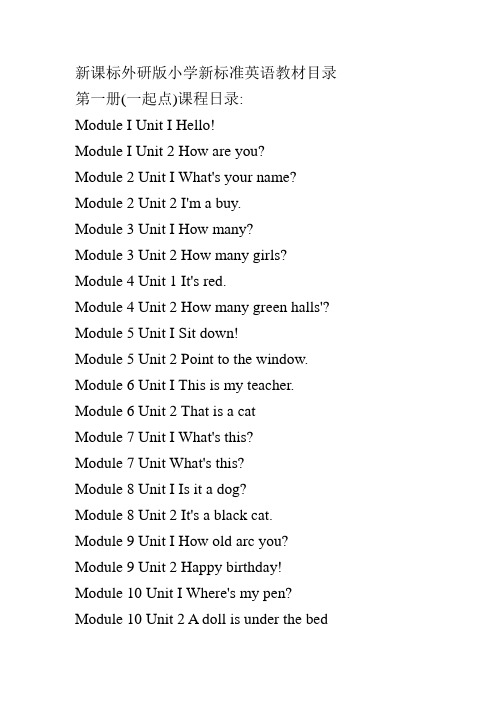
新课标外研版小学新标准英语教材目录第一册(一起点)课程日录:Module I Unit I Hello!Module I Unit 2 How are you?Module 2 Unit I What's your name? Module 2 Unit 2 I'm a buy.Module 3 Unit I How many?Module 3 Unit 2 How many girls? Module 4 Unit 1 It's red.Module 4 Unit 2 How many green halls'? Module 5 Unit I Sit down!Module 5 Unit 2 Point to the window. Module 6 Unit I This is my teacher. Module 6 Unit 2 That is a catModule 7 Unit I What's this?Module 7 Unit What's this?Module 8 Unit I Is it a dog?Module 8 Unit 2 It's a black cat. Module 9 Unit I How old arc you? Module 9 Unit 2 Happy birthday! Module 10 Unit I Where's my pen? Module 10 Unit 2 A doll is under the bed外研社小学新标准英in(新版)第二册(一起点)课程目录:Module I UNIT I Where's the cat?Module I UNIT 2 How many green birds? Module 2 UNIT I That is my father.Module 2 UNIT 2 He's a doctor.Module 3 UNIT I This is her hag.Module 3 UNIT 2 My mother is a nurse. Module 4 UNIT I This is my head.Module 4 UNIT 2 These arc your legs. Module 5 UNIT I They're cows.Module 5 UNIT 2 It's thin.Module 6 UNIT I That snake is long.Module 6 UNIT 2 The baby lions are cute. Module 7 UNIT I Let's play football!Module 7 UNIT 2 Let's sing!Module 9 1刀NIT I I like footballModule 8 UNIT 2 What's your favourite sport'? Module 9 UNIT I I don't like meat.Module 9 UNIT 2 I don't like ginger.Module 10 UNIT I Do you like dolls? Module 10 UNIT 2 Do they like jigsaws?REVIEW MODULE UNIT I He's a driver. REVIEW MODULE UNIT 2 It's small.Reading for Pleasure外研社小学新标准英语(新版)第三册(一起点)课程日录:Module I UNIT I I like the ABC song.Module I UNIT 2 What do you like?Module 2 UNIT I He likes this T-shirt.Module 2 UNIT 2 He doesn't like this shirt. Module 3 UNIT I We have English in the morning. Module 3 UNIT 21 like PE.Module 4 UNIT I It's 2 o'clock.Module 4 UNIT 2 What's the time?Module 5 UNIT I I act un at 7 o'clock in the morning Module 5 UNIT 2 It's half past 7Module 6 UNIT I She watches TV.Module 6 UNIT 2 Does he play the flute?Module 7 UNIT I What do you do at the weekend? Module 7 UNIT 2 Where do you live?Module 8 UNIT I How do you go to school? Module 8 UNIT 2 1 go by train.Module 9 UNIT I It's winter.Module 9 UNIT 2 It's warm.Module I O UNIT I Happy New Year!Module 10 UNIT 2 We have Christmas.REVIEW MODULE UNIT I What's the time, Mr Wolf? REVIEW MODULE UNIT 2 Does Amy like English? REVIEW MODULEReading for pleasure It's under the desk.[/b〕外研社小学新标准英语(新版)第Vqffi(一起点)W程1 1录: [/b]Module I Unit I What's the weather like?Module I Unit 2 1 like swimming.Module 2 Unit I She's listening to the radio.Module 2 Unit 2 I'm drawing a picture.Module 3 Unit I Sam isn't tidying his room.Module 3 Unit 2 Are you doing your homework? Module 4 Unit I What are you doing?Module 4 Unit 2 What's she doing?Module 5 Unit I Lingling is skipping.Module 5 Unit 2 What are you playing?Module 6 Unit I I usually play basketball.Module 6 Unit 2 We are helping her.Module 7 Unit I It's Children's Day today.Module 7 Unit 2 We're having a picnic.Module 8 Unit I The train is going up a hill. Module 8 Unit 2 We're turning around.Module 9 Unit】Turn left!Module 9 Unit 2 Where do you live?Module 10 Unit I It's next to the park.Module 10 Unit 2 Where's the toilet, please? REVIEW MODULE Unit I I wear shorts on hot days. REVIEW MODULE Unit 2It's next to the tree. Reading for Pleasure The Three Little Pigs外研社小学新标准英语(新版)第五册(一起点)课程I'录:Module I Unit I Do you use chopsticks in England? Module I Unit 2 I'm eating hamburgers and chips Module 2 Unit I We're making a cakeModule 2 Unit 2 I'm watching TVModule 3 Unit I These ducks are very naughty Module 3 Unit 2 This is Sam's sweater.Module 4 Unit I Can you run fast?Module 4 Unit 2 This bird can flyModule 5 Unit I Can I have an ice cream?Module 5 Unit 2 Can I come in?Module 6 Unit I I've got a new kiteModule 6 Unit 2 She's got a pct catModule 7 Unit I Have you got a headache?Module 7 Unit 2 She's got a coldModule 8 Unit I There are stone animalsModule 8 Unit 2 How many people are there in your family?Module 9 Unit I I'm going to do long jumpModule 9 Unit 2 I'm going to be a driverModule 10 Unit I Are you going to go to Hong Kong? Module 10 Unit 2 What are you going to see'? Reading for Pleasure The Little Red HenReading for Pleasure By the sea外研社小学新标准英语(新版第六册(一起点)课程日录:Module I UNIT I She's very nic:Module I UNIT 2 I'm going to h :lp heiModule 2 UNIT I It's very long.Module 2 UNIT 2 You'll see Tov er Bri ge.Module 3 UNIT I Maybe we'll go to the zoo.Module 3 UNIT 2 Will you phone me?Module 4 UNIT I Maybe I'll be a writer.Module 4 UNIT 2 He'll he an astronaut.Module 5 UNIT I We'll pick fruit.Module 5 UNIT 2 There are fourteen peaches. Module 6 UNIT I He works hard.Module 6 UNIT 2 She's quite good at English. Module 7 UNIT I They were very young.Module 7 UNIT 2 He was in Hong Kong.Module 8 UNIT I Were you on the second floor? Module 8 UNIT 2 It was there.Module 9 UNIT I Tomorrow is Friday.Module 9 UNIT 2 He will sleep on Sunday.Module 10 UNIT I There are fifty children in my class. Module 10 UNIT 2 What's sixty plus thirty? REVIEW MODULE UNIT I Will you go swimming? Reading for Pleasure Jack and the Beanstalk Reading for Pleasure My Uncle Jimmy外研社小学新标准英语(新版)第七册(一起点)课程目录:Module I UNIT I Lucy lives in London.Module I UNIT 2 I've got a new friend.Module 2 UNIT I I helped my mum.Module 2 UNIT 2 Amy painted a picture.Module 3 UNIT I She didn't walk to school yesterday. Module 3 UNIT 2 1 didn't play football.Module 4 UNIT I Chinese people invented paper. Module 4 UNIT 2 He invented this bicycle in 1839. Module 5 UNIT I We went to the Great Wall.Module 5 UNIT 2 1 wore warm clothes.Module 6 UNIT I It didn't make gold.Module 6 UNIT 2 He didn't come back.Module 7 UNIT I Did you break your toy?Module 7 UNIT 2 There were three children.Module 8 UNIT I What did she play?Module 8 UNIT 2 Where did you go?Module 9 UNIT I What happened to you?Module 9 UNIT 2 1 humped my head.Module 10 UNIT I I've got a stomach ache.Module 10 UNIT 2 Wang Fei's got a coldREVIEW MODULE UNIT I Yesterday was a special day.外研社小学新标准英语(新版)第八册(一起点)课程目录:MODULE I FRIENDS Unit I Amy is taller than LinglingMODULE I FRIENDS Unit 2 You arc older than me. MODULE 2 FACTORY VISIT Unit I Don't touch the machines!MODULE 2 FACTORY VISIT Unit 2 Don't feed the ducks!MODULE 3 COMPUTERS Unit I It's more expensive. MODULE 3 COMPUTERS Unit 2 Lucy Locket lost her wallet.MODULE 4 MUSIC Unit I I love this music. MODULE 4 MUSIC Unit 2 1 am the music man. MODULE 5 SINGING CONTEST Unit I This girl is better.MODULE 5 SINGING CONTEST Unit 2 Sing to your daddy.MODULE 6 ENGLISH NEWSPAPER Unit I That's a great idea!MODULE 6 ENGLISH NEWSPAPER Unit 2 Let's take our kites!MODULE 7 SPACE Unit I This one is the biggest planet.MODULE 7 SPACE Unit 2 Twinkle, Twinkle Little StarMODULE 8 AMERICA Unit】To the south is Mexico. MODULE 8 AMERICA Unit 2 Yankee Doodle came to town.MODULE 9 GEOGRAPHY Unit I Where is the most beautiful place?MODULE 9 GEOGRAPHY Unit 2 I went to the east. MODULE 10 SUMMER HOLIDAYS Unit I I'll send you a postcard.MODULE 10 SUMMER HOLIDAYS Unit 2 1 will have adventures.REVIEW MODULE STOTY TIME Unit I Chinese PearsREADING FOR PLEASURE 1. The Lantern Festival READING FOR PLEASURE 2. Two Lions READING FOR PLEASURE 3.Huojia and the Moon READING FOR PLEASURE 4. The Girl and the Frog 外研社小学新标准英语(新版)第九册(一起点)课程目录:Module I UNIT I There wasn't a pondModule I UNIT 2 There are tall trees.Module 2 UNIT I This one is heavy.Module 2 UNIT 2 They sell different things.Module 3 UNIT I Today is Halloween.Module 3 UNIT 2 Easter is in spring.Module 4 UNIT I We're going to sing and dance. Module 4 UNIT 2 Amy is going to be 11. Module 5 UNIT I It's mine!Module 5 UNIT 2 Amy's blue dress is wet. Module 6 UNIT I You can play basketball well Module 6 UNIT 2 They got fifty points. Module 7 UNIT I This dog can help him. Module 7 UNIT 2 It could hear the people. Module 8 UNIT I They sit around tables. Module 8 UNIT 2 There are lots games. Module 9 UNIT I Are you sad?Module 9 UNIT 2 Zara was happy.Module I O UNIT I You should tidy your toys. Module 10 UNIT 2 You shouldn't he late.外研社小学新标准英语(新版)第十册(一起点)课程11录:Module I Unit I She was a driver before. Module I Unit 2 He worked in an office. Module 2 Unit!What did she have for lunch? Module 2 What did she have for lunch'?Module 3 Unit I Have you got the Harry Potter videos? Module 3 Unit 2 You can use the computers.Module 4 Unit I Did you read them?Module 4 Unit 2 My favourite season is spring. Module 5 Unit I Your bag is broken!Module 5 Unit 2 Mine is pink.Module 6 Unit I We'll see lots of stones.Module 6 Unit 2 It was amazing.Module 7 Unit I Write your message.Module 7 Unit 2 1 will be home at seven o'clock. Module 8 Unit I Will you help me?Module 8 Unit 2 How I made the kite.Module 9 Unit I We laughed a lot.Module 9 Unit 2 That will he fun!Module 10 Unit I What did you put in your hag? Module 10 Unit 2 1 played on the beach.REVIEW MODULE Unit 2 He wore a white coat. Reading for Pleasure The Girl in the Pagoda Reading for Pleasure A Special PetReading for Pleasure Louis Braille外研社小学新标准英语(新版)第十一册(一起点)课程目录:MODULE I Unit I How long is the Great Wall? MODULE I Unit 2 It's twenty metres tall.MODULE 2 Unit I There is a big Chinatown in New York.MODULE 2 Unit 2 1 went to a library yesterday. MODULE 3 Unit I Have you got any stamps from China?MODULE 3 Unit 2 These stamps arc from America. MODULE 4 Unit I Can you tell me about American festivals?MODULE 4 Unit 2 It's a very important festival. MODULE 5 Unit I Can I write to her?MODULE 5 Unit 21 want a Chinese pen pal. MODULE 6 Unit I I've got sonic Chinese chopsticks. MODULE 6 Unit 2 1 haven't got a book about America.MODULE 7 Unit I Pandas love bamboo.MODULE 7 Unit 2 A child sleeps for eight hours a night.MODULE 8 Unit I Do you often tidy your room'? MODULE 8 Unit 2 I often help my mum.MODULE 9 Unit I Do you want to visit the UNbuilding?MODULE 9 Unit 2 What do you like doing? MODULE 10 Unit I Only drink clean water! MODULE 10 Unit 2 Stand in line!REVIEW MODULEReading for pleasure AReading for pleasure B外研社小学新标准英语(新版)第I一二册(一起点)课程目录:MODULE I Unit I I want a hot dog.MODULE I Unit 2 What do you want to cat? MODULE 2 Unit I We're going to have a picnic. MODULE 2 Unit 2 It's going to rain.MODULE 3 Unit I I took some photos.MODULE 3 Unit 2 We are having our picnic. MODULE 4 Unit I I can't carry them all.MODULE 4 Unit 2 The apples are falling down the stairs.MODULE 5 Unit I He is playing but then the telephone ringsMODULE 5 Unit 2 I am flying in the sky.MODULE 6 Unit I I bought a book for you.MODULE 6 Unit 2 The name of the spaceship is ShcnzhouMODULE 7 Unit I He spent about 21 hours in space. MODULE 7 Unit 2 Ningkang's dad is famous. MODULE 8 Unit I Helen KellerMODULE 8 Unit 2 Helen,5 First WordMODULE 9 Unit I What's the matter?MODULE 9 Unit 2 Why are you scared?MODULE 10 Unit I Are you going to go to middle school?MODULE 10 Unit 2 There are 2,500 students at the school.REVIEW MODULE Unit 2 Who are they talking about'?。
小学英语一起第8册重点内容

1.Welcome to our factory, children! 孩子们,欢迎来到我们的工厂!2.These machines make crisps. 这些机器切片。
3.What does this machine do, sir? 先生,这台机器做什么?4.It washes the potatoes.它清洗土豆。
5.This machine cuts the potatoes. 这台机器切土豆。
6.Don’t touch the machines, please!请别碰机器。
7.They are dangerous. 它们很危险。
8.Sorry, sir. 对不起,先生。
9.This machine puts the crisps in the bags. 这台机器把切片放入袋中。
10. Wait! 等一下!11. You are a very good class. 你们是一个好班级。
12. You can each have a bag of crisps. 你们可以每人拥有一袋薯片。
13, Thank you, sir. 谢谢你,先生。
Module 1 Unit 21.Don’t touch the baby!别碰这个孩子!2.Sing for the baby! 给这个宝宝唱歌!3.Play with the baby! 和这个宝宝玩耍!4.Don’t feed the fish!别喂鱼!5.Don’t walk on the grass!别在草地上散步!6.Don’t play ball games here!这里别玩球!7.Don’t talk!别讲话!8.Don’t write on the books! 别在书上写字!9.Now come along! 现在一起来!10. I tell you all! 我告诉你们所有人!11. Don’t shout or run!别跑也别喊!12. Come and do your homework, one by one! 一个接一个过来做作业!Module 2 Unit 11.Guess! 猜一猜!2.Dad bought a computer for me yesterday. 昨天爸爸给我买了一台电脑。
Module 2 Unit 1 What did she have for lunch.(教案)-2
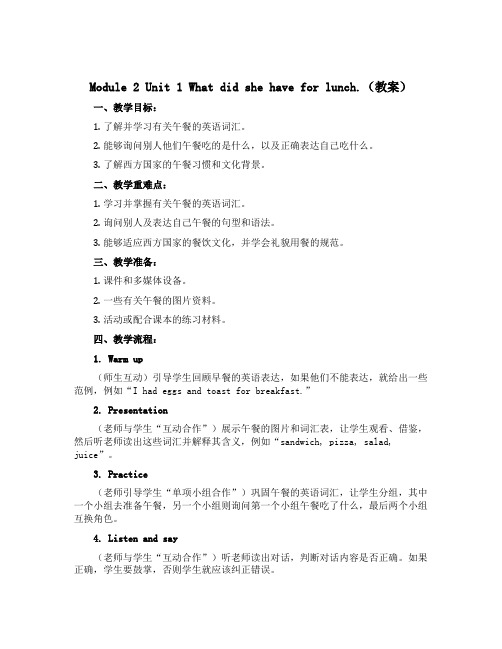
Module 2 Unit 1 What did she have for lunch.(教案)一、教学目标:1.了解并学习有关午餐的英语词汇。
2.能够询问别人他们午餐吃的是什么,以及正确表达自己吃什么。
3.了解西方国家的午餐习惯和文化背景。
二、教学重难点:1.学习并掌握有关午餐的英语词汇。
2.询问别人及表达自己午餐的句型和语法。
3.能够适应西方国家的餐饮文化,并学会礼貌用餐的规范。
三、教学准备:1.课件和多媒体设备。
2.一些有关午餐的图片资料。
3.活动或配合课本的练习材料。
四、教学流程:1. Warm up(师生互动)引导学生回顾早餐的英语表达,如果他们不能表达,就给出一些范例,例如“I had eggs and toast for breakfast.”2. Presentation(老师与学生“互动合作”)展示午餐的图片和词汇表,让学生观看、借鉴,然后听老师读出这些词汇并解释其含义,例如“sandwich, pizza, salad, juice”。
3. Practice(老师引导学生“单项小组合作”)巩固午餐的英语词汇,让学生分组,其中一个小组去准备午餐,另一个小组则询问第一个小组午餐吃了什么,最后两个小组互换角色。
4. Listen and say(老师与学生“互动合作”)听老师读出对话,判断对话内容是否正确。
如果正确,学生要鼓掌,否则学生就应该纠正错误。
5. Read and write(老师引导学生“自主合作”)示范写一篇有关午餐的小短文,让学生跟随,用英语写下自己今天午餐吃了什么,也可以写下他们的同桌吃的东西。
6. Wrap up(老师与学生“互动合作”)总结本节课学到的知识和经验,让学生回答下面的问题:1. What did you learn in today’s class? 2. Can you say three words about lunch? 3. What is the difference between your lunch and that of a Western country? 4. What’s your favorite lunch?五、延伸训练(老师引导学生“自主合作”)课后再准备几个练习,如填空、连线和口语互动等,以加深学生对所学知识的理解和掌握。
外研(一起)五下M2U1What did you have for lunch教学设计
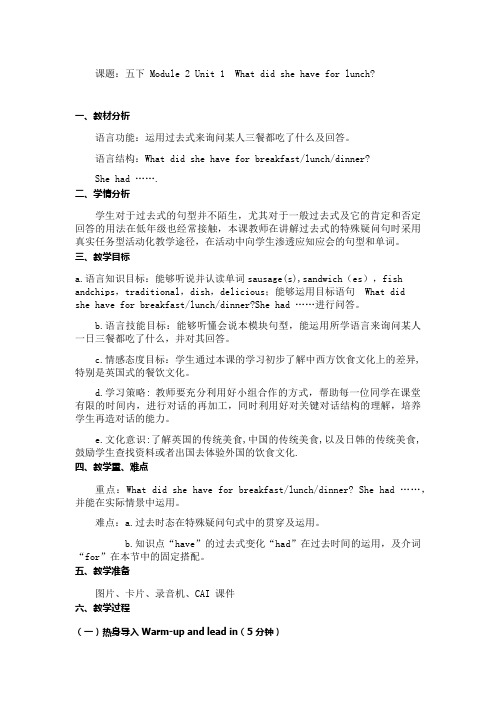
课题:五下 Module 2 Unit 1 What did she have for lunch?一、教材分析语言功能:运用过去式来询问某人三餐都吃了什么及回答。
语言结构:What did she have for breakfast/lunch/dinner?She had …….二、学情分析学生对于过去式的句型并不陌生,尤其对于一般过去式及它的肯定和否定回答的用法在低年级也经常接触,本课教师在讲解过去式的特殊疑问句时采用真实任务型活动化教学途径,在活动中向学生渗透应知应会的句型和单词。
三、教学目标a.语言知识目标:能够听说并认读单词sausage(s),sandwich(es),fish andchips,traditional,dish,delicious;能够运用目标语句What didshe have for breakfast/lunch/dinner?She had ……进行问答。
b.语言技能目标:能够听懂会说本模块句型,能运用所学语言来询问某人一日三餐都吃了什么,并对其回答。
c.情感态度目标:学生通过本课的学习初步了解中西方饮食文化上的差异,特别是英国式的餐饮文化。
d.学习策略:教师要充分利用好小组合作的方式,帮助每一位同学在课堂有限的时间内,进行对话的再加工,同时利用好对关键对话结构的理解,培养学生再造对话的能力。
e.文化意识:了解英国的传统美食,中国的传统美食,以及日韩的传统美食,鼓励学生查找资料或者出国去体验外国的饮食文化.四、教学重、难点重点:What did she have for breakfast/lunch/dinner? She had ……,并能在实际情景中运用。
难点:a.过去时态在特殊疑问句式中的贯穿及运用。
b.知识点“have”的过去式变化“had”在过去时间的运用,及介词“for”在本节中的固定搭配。
五、教学准备图片、卡片、录音机、CAI 课件六、教学过程(一)热身导入Warm-up and lead in(5分钟)a. Greeting. Hello. How are you?b. 看图说食物的单词,并学习新词sausage(s),sandwich(es). 及单复数的认读,拼读。
五年级下英语【教学设计】-Module2Unit1 What did she have for lu

五年级下英语教学设计-Module2Unit1 What did she have forlunch-外研版(一起)教学目标本节课的教学目标主要有以下几点:1.能听懂并且会用英语描述食物。
2.能够运用英语询问别人有什么食物。
3.能够用英语描述某个人的午餐内容。
教学步骤导入部分教师可以通过播放一些与食物相关的视频,或是向学生介绍一些健康饮食的理念,来激发学生的兴趣。
学习新单词通过幻灯片、图片或实物向学生展示一些常见的食物,并教授相应的单词。
教师可以用图片、动画等富有趣味的方式来帮助学生记忆。
学习新句型本课重点是学习“What did she have for lunch?”这个句型。
通过结合图片、视频等多种方式,展示一些人的午餐内容,并引导学生使用这个句型来描述午餐内容。
练习在学习了新单词和新句型后,可以通过以下几种方式进行练习:1.小组问答练习。
分成小组,互相询问午餐内容,回答并且重复提问,加深记忆。
2.模仿练习。
学生在老师的指导下互相模仿对话,通过互相反复模仿,加深印象。
3.任务型练习。
老师提供一些午餐相关的任务,让学生在理解和使用新知识的基础上完成任务,如小组选择午餐食物并用英语描述,或是用英文写下今天午餐的内容等。
布置作业1.阅读和复制复习单词,使其能够熟练掌握。
2.写一篇短文,描述今天或昨天的午餐内容。
教学评价与反思教师可以通过测试、评估学生口头表达和写作等多种方式,来评价学生对本节课所学内容的掌握情况,并针对学生表现出的困难或不足之处,进行调整和改进。
在课后反思中,教师可以结合学生的表现和评价结果,来调整教学方法和提高教学质量,以达到更好的教学效果。
五年级下册英语知识点整理
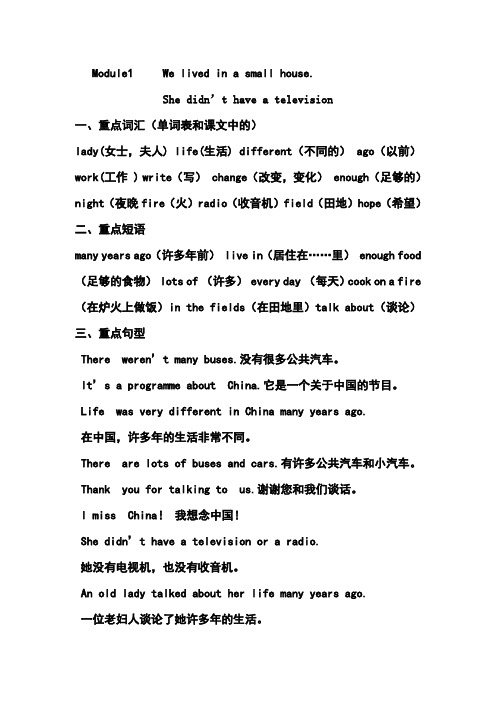
Module1 We lived in a small house.She didn’t have a television一、重点词汇(单词表和课文中的)lady(女士,夫人) life(生活) different(不同的) ago(以前)work(工作 ) write(写) change(改变,变化) enough(足够的)night(夜晚fire(火)radio(收音机)field(田地)hope(希望)二、重点短语many years ago(许多年前) live in(居住在……里) enough food (足够的食物) lots of (许多) every day (每天)cook on a fire (在炉火上做饭)in the fields(在田地里)talk about(谈论)三、重点句型There weren’t many buses.没有很多公共汽车。
It’s a programme about China.它是一个关于中国的节目。
Life was very different in China many years ago.在中国,许多年的生活非常不同。
There are lots of buses and cars.有许多公共汽车和小汽车。
Thank you for talking to us.谢谢您和我们谈话。
I miss China!我想念中国!She didn’t have a television or a radio.她没有电视机,也没有收音机。
An old lady talked about her life many years ago.一位老妇人谈论了她许多年的生活。
She couldn’t read or write. 她不会读也不会写。
四、自然拼读ai,ay /ei/ rain play al,au /ɔ: / walk autumn ar/ɑ:/ farmer party ar/ɔ:/ warm quarter五、背诵重点:课文第二部分六、语法点:过去式Module 2 She learnt English.Mr Li was a teacher.一、重点词汇learnt 学习(learn的过去式) foreign(外国的) studied 学习(study的过去式) language(语言) taught 教,讲授(teach 的过去式) wrote 写(write的过去式) dancer(舞蹈演员) hard (努力地)二、重点短语Foreign language(外语) learn English(学习英语) make a cake(做蛋糕)twenty years ago(二十年前)in his class(在他班里) a good pupil(一个好学生) an English teacher(一位英语老师) walk to school(步行去上学) by school bus(乘坐校车)三、重点句子Did she learn any foreign language她学过外语吗But he’s learning English now.但是他现在正在学习英语。
五下英语课文全册翻译

M1U11Look,listen and say部分翻译Lingling:Look,there are two beautiful cats on the chair.玲玲:看,在椅子上有两只漂亮的猫。
Sarm:There is only one now.萨姆:现在仅有一只了。
Lingling:Well,there were two.玲玲:唔,(刚才)有两只。
2Listen,read and act out部分翻译Lingling is still in the UK with Sam and Amy.玲玲仍然和萨姆、埃米在英国。
Amy:Look,lingling! lt's a progamme about China.埃米:看,玲玲!它是一个关于中国的节目。
Come and watch!过来看!Lingling:l'm coming!玲玲:我来了!Old lady:Life was very different in China na many years ago. 老妇人:许多年前中国的生活很不同。
interviewer:How was l tdifferent?采访者:它是怎样不同的?Old lady:We lived in a small house. We didn't have enough food.There weren't many buses.There weren't any televisions.老妇人:我们住在一个小房子里。
我们没有足够的食物。
没有很多公共汽车。
没有电视机。
interviewer:How about now?采访者:现在呢?Old lady:We live in a big house. We've got lots of food.There are lots of buses an dcars. I watch TV every day.Yesterday I watched TV with my grandchildren.老妇人:我们住在一个大房子里。
外研版三起小学英语五年级下册电子课本
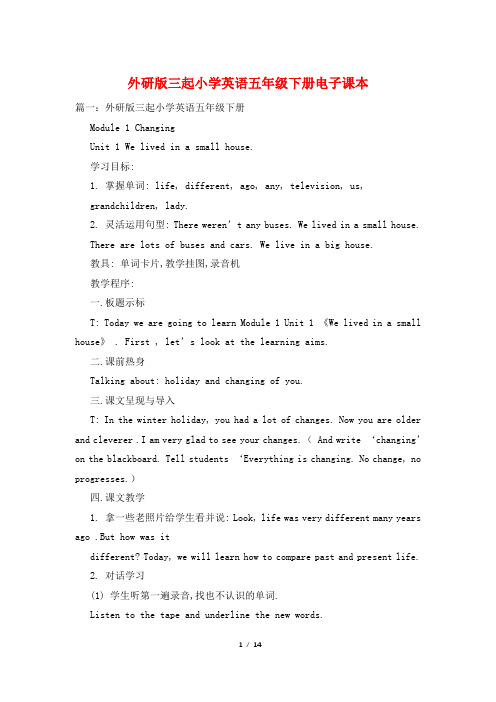
外研版三起小学英语五年级下册电子课本篇一:外研版三起小学英语五年级下册Module 1 ChangingUnit 1 We lived in a small house.学习目标:1. 掌握单词: life, different, ago, any, television, us,grandchildren, lady.2. 灵活运用句型: There weren’t any buses. We lived in a small house. There are lots of buses and cars. We live in a big house.教具: 单词卡片,教学挂图,录音机教学程序:一.板题示标T: Today we are going to learn Module 1 Unit 1 《We lived in a small house》 . First , let’s look at the learning aims.二.课前热身Talking about: holiday and changing of you.三.课文呈现与导入T: In the winter holiday, you had a lot of changes. Now you are older and cleverer .I am very glad to see your changes.( And write ‘changing’on the blackboard. Tell students ‘Everything is changing. No change, no progresses.)四.课文教学1. 拿一些老照片给学生看并说: Look, life was very different many years ago .But how was itdifferent? Today, we will learn how to compare past and present life.2. 对话学习(1) 学生听第一遍录音,找也不认识的单词.Listen to the tape and underline the new words.(2) 学生听第二遍录音,跟读自己不认识的单词.Listen to the tape-recorder and read follow it .(3) 学生听第三遍录音的同时,T把一些新单词写在黑板上,领读学生掌握不好的词.示例:life, different, ago, any, television, grandmother, grandfather(4) 听第四遍录音,学生跟读.要求:边听边指,注意模仿语音语调.(5) 学生四人一组练习对话,五分钟后,看哪组同学的对话读得最流利.3. 学生活动.T准备一些图片或实物,学生练习描述.并分组比赛哪个组回答的快.例:一棵大树,一棵小树.There is a big tree, there is a small tree.They are different.一个空盒子,一个装了很多纸的盒子.There aren’t any papers. There are lots of papers.五、总结及做作业1. SummaryT: Today we have learnt “How to describe past and present life, review simple past tense and present tense.”2. Today’s homeworka. Listen and read Unit1 three times, try to recite and act.b. Compare two photos and write differences.Module 1 ChangingUnit 2 She didn’t have a television.学习目标:1. 掌握单词: fire, radio, telephone, field, hope.2. 灵活运用句型: She worked in the fields. She didn’t have a television.3. 学习写信的格式4. 了解字母组合ai, ay, al, au, ar, 在单词中常见的读音.教具: 单词卡片,教学挂图,录音机教学程序:一.板题示标T: Today we are going to learn Module 1 Unit 2 《She didn’t have a television.》First ,let’s look at the learning aims.二.课文导入Yesterday, Lingling saw the programme about China, she missed her grandmother very much.三.课文教学1. 文章学习(1)学生听第一遍录音,找出不认识的单词.Listen to the tape and underline the new words.(2)学生听第二遍录音,跟读自己不认识的单词.Listen to the tape-recorder and read follow it .(3)学生听第三遍录音思考以下问题.a. What programme did Lingling watch last night?b. What was the old lady’s life like many years ago?c. Who does Lingling miss?(4)听第四遍录音后学生讨论上述问题,并派选手参加每个问题的抢答.在抢答的同时,T把一些生单词写在黑板上,领读学生掌握不好的词.(10分钟后看看哪个小组最棒,T给获胜的小组加分).(5)听第五遍录音,学生跟读.要求:边听边指,注意模仿语音语调.2.学生活动So she writes a letter for Daming and tells about that programme and her feeling.(1)活动1拿出单词卡Television, radio, telephone, 让学生用She didn’t have/He didn’t have/we didn’t have 造句子.(1)做游戏Put nine cards on the desk. Two students use cards to make dialogue. For example:A: Where was he/she seven days ago?B: He/She was ?A: What did he/she do there?B: He/She ?四. 语音学习1.T播放SB Unit 2 活动1的录音磁带,全班同学听并跟读.2.学生一边听一边划线,一边说单词.3.T把单词rain, play, all, autumn, star, party, warm, quarter贴到黑板上,一边贴,学生一边读.4.学生跟据读音,找也发音规律,然后要求学生把这些单词照读音分组.五.学唱歌1.放第一遍录音,学生认真听.2.放第二遍录音,每句一停,让学生重复.3.边听边唱.Module 2 GrandparentsUnit 1 She learnt English.学习目标:1. 掌握单词: learnt these dancer2. 灵活运用句型: She learnt English.Did she learn any foreign languages?He is learning English now.3.了解字母组合ai, ay, al, au, ar, 在单词中常见的读音.教具:单词卡片,教学挂图,录音机教学程序:一.板题示标T: Today we are going to learn Module 2 Unit 1《She learnt English》. First , let’s look at the learning aims.二.热身复习用上节课学的句子She didn’t have ?照句.三.课文教学1. 文章学习(1)学生听第一遍录音,找出不认识的单词.Listen to the tape and underline the new words.(2)学生听第二遍录音,跟读自己不认识的单词.Listen to the tape-recorder and read follow it .(3) 听第四遍录音,学生跟读.要求:边听边指,注意模仿语音语调2.学生活动(1)活动1让学生三人一组,分别扮演对话中的Linging , Amy和Sam.检测:请学生将对话演出来,表演时可以离开座位自由对话,最后请自愿者在全班同学面前表演.(10分钟后,比比看哪个小组表演的最棒)(2)活动2问题/回答Did you/he /she ?..? Yes, I/she/he did. No, didn’t.He is doing ??.Have Ss look it , give some minutes to practise in pairs ,then act it out.Module 2 GrandparentsUnit 2 Mr Li was a teacher.学习目标:1. 掌握单词: study hard retired2. 灵活运用句型: Mr Li was a teacher. He taught Chinese.Chen Hai is an English teacher. He’s teaching Mr Li.3.了解字母组合aw, air,ass 在单词中常见的读音.教具:单词卡片,教学挂图,录音机教学程序:一.板题示标T: Today we are going to learn Module 2Unit 1 Mr Li was a teacher , first ,let’s look at the learning aims.二.热身复习与课堂导入1.复习上节课学过的单词和句子老师问:Did you learn English?学生回答:Yes, I did.2.老师让一名学生站在讲台的前面说以下:T: Ten years ago, I was a student . Now, I am a teacher. Ok, let’s come to the text.三.课文教学1. 学生活动让学生自己先读一遍课文,划出不认识的生词.出示单词卡,老师重点讲解生词.带同学重复读生词.播放录音,学生听并跟读课文.同桌相互朗读.2.分组练习二人一组,分别扮演书中的老师和学生,用第一人称I进行描述.例:Ten years ago, I was a teacher, I taught Chinese. Now, I am retired.I am learning English. Ten years ago, I was a student, I studied very hard. Now, I am an English teacher.3.身体语言请两位同学到讲台前做读书,写字,跳舞的动作,老师问What did he/she do? 学生回答He/she read a book/danced/written.请两位同学上来台上,一人作,一人说。
五年级下册英语教案-Module2Unit 1 What did she have for lunc

五年级下册英语教案-Module2Unit 1 What did she have forlunch (2) 外研版(一起)教学目标•学习并掌握食物的词汇:rice, chicken, fish, vegetables, noodles, juice, water。
•能够通过询问和回答What did you/they have for…?的句型,来描述自己和别人吃的午餐。
•能够使用食物的词汇,采用自然而然的方式来进行交流。
教学重点•学生能够掌握食物的词汇和句型,并运用于实际情境中。
•学生能够运用自己所学的知识来进行交流,并能够理解他人所说的内容。
教学准备•PPT课件•小黑板或白板等教学辅助工具教学过程一、引导学生回忆上一课时所学内容教师可以通过问学生一些问题来检测学生是否能够对上一课时所学的内容进行回忆,如What did you have for lunch yesterday?等。
二、呈现新课内容1. 引导学生学习新单词教师可以通过PPT呈现新单词,示范发音,并让学生跟读,然后进行清晰度的练习。
新单词:rice, chicken, fish, vegetables, noodles, juice, water。
2. 学习句型通过PPT呈现句型What did she/he have for…?,并示范如何构建句子,然后让学生模仿进行练习。
3. 大声朗读让学生进行认读练习,并引导学生进行发音练习。
然后逐个呈现单词和句子,并让学生进行大声朗读练习。
4. 练习通过PPT呈现一些实际情境的问答对话,让学生进行练习。
三、巩固和延伸(50分钟)1. 学生自主练习(20分钟)将学生分成小组,每个小组进行三分钟的练习,以询问和回答What didyou/they have for…?的句型为主,让学生进行自由操练,并根据需要加以辅导和点拨。
2. 课堂巩固(20分钟)设计一些小游戏或活动,如联想游戏、分类游戏等,让学生巩固所学的知识点。
新外研版四年级上册 Module 2 unit 1
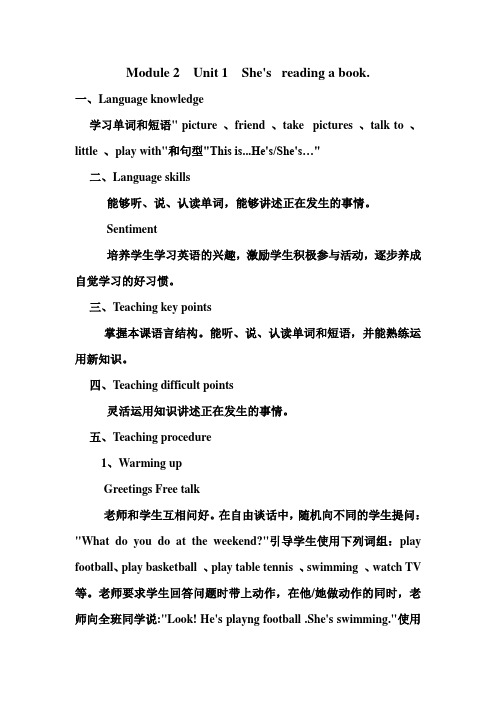
Module 2 Unit 1 She's reading a book.一、Language knowledge学习单词和短语" picture 、friend 、take pictures 、talk to 、little 、play with"和句型"This is...He's/She's…"二、Language skills能够听、说、认读单词,能够讲述正在发生的事情。
Sentiment培养学生学习英语的兴趣,激励学生积极参与活动,逐步养成自觉学习的好习惯。
三、Teaching key points掌握本课语言结构。
能听、说、认读单词和短语,并能熟练运用新知识。
四、Teaching difficult points灵活运用知识讲述正在发生的事情。
五、Teaching procedure1、Warming upGreetings Free talk老师和学生互相问好。
在自由谈话中,随机向不同的学生提问:"What do you do at the weekend?"引导学生使用下列词组:play football、play basketball 、play table tennis 、swimming 、watch TV 等。
老师要求学生回答问题时带上动作,在他/她做动作的同时,老师向全班同学说:"Look! He's playng football .She's swimming."使用这种方法呈现更多新语言。
2、Presentation学习单词、短语。
老师釆用“温故而知新”的方法教授新单词和短语。
例如:white-write 、lake-take 、walk-talk。
让学生自己先试着读,然后结合图画熟练掌握新单词和短语。
3、Learn the text请学生仔细观察图画,认真阅读课文,帮助学生弄清楚故事内容和情节:Sam正在展示自己的绘画作品,其中有Lingling写信的画,Daming照相的画,Amy打电话的画,还有Tom玩玩具火车的画。
Module 2 Unit 1 What did she have for lunch(教案)-20
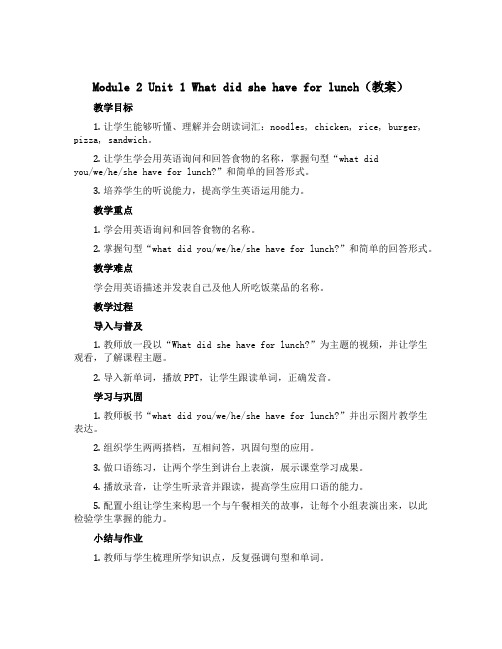
Module 2 Unit 1 What did she have for lunch(教案)教学目标1.让学生能够听懂、理解并会朗读词汇:noodles, chicken, rice, burger, pizza, sandwich。
2.让学生学会用英语询问和回答食物的名称,掌握句型“what didyou/we/he/she have for lunch?”和简单的回答形式。
3.培养学生的听说能力,提高学生英语运用能力。
教学重点1.学会用英语询问和回答食物的名称。
2.掌握句型“what did you/we/he/she have for lunch?”和简单的回答形式。
教学难点学会用英语描述并发表自己及他人所吃饭菜品的名称。
教学过程导入与普及1.教师放一段以“What did she have for lunch?”为主题的视频,并让学生观看,了解课程主题。
2.导入新单词,播放PPT,让学生跟读单词,正确发音。
学习与巩固1.教师板书“what did you/we/he/she have for lunch?”并出示图片教学生表达。
2.组织学生两两搭档,互相问答,巩固句型的应用。
3.做口语练习,让两个学生到讲台上表演,展示课堂学习成果。
4.播放录音,让学生听录音并跟读,提高学生应用口语的能力。
5.配置小组让学生来构思一个与午餐相关的故事,让每个小组表演出来,以此检验学生掌握的能力。
小结与作业1.教师与学生梳理所学知识点,反复强调句型和单词。
2.布置作业:让学生到家里询问几个人午饭吃的是什么,然后用句型“what did you have for lunch?”来询问,把回答写下来,并在下节课时让学生发音。
教学反思本节课是希望让学生能够掌握简单的口语应用,在练习问答的过程中,教师要多鼓励学生,让每个学生都有参与感,让他们在练习中不断探究,多听多说,锻炼口语能力。
最后一定要让每个学生都有练习发音的机会,使学生能够真正掌握所学知识。
Module2Unit1ShelearntEnglish(课件)-英语五年级下册
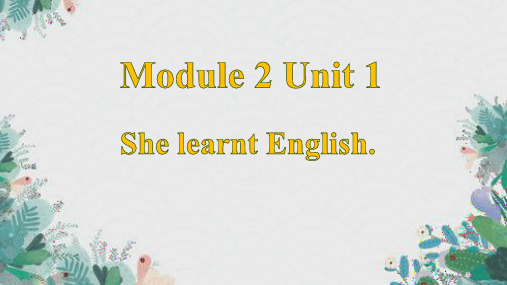
No, she didn’t.
Yes, he did.
watch TV
She didn’t make a He watched TV yesterday. cake yesterday.
do homework
go to the zoo
She did her homework He didn’t go to the
She learnt to talk last night.
The boy learnt to ride a bike yesterday.
learn-learnt
learn sth.
Grandma and grandpa learnt English. languages
The kids learnt Chinese.
Let’s listen.
dancer danced in lots of Chinese cities
driver
—Did grandma learn any foreign languages?
—Yes, she learnt English.
—Did grandpa learn English?fornins
—No, he didn't learn English. But he's learning English now.
foreign
foreign city
foreign holiday
foreign drinks
foreign food
Listen and read.
Practise.
Did she make a cake yesterday?
Yesterday Ms Smart...
英语分层教学案例
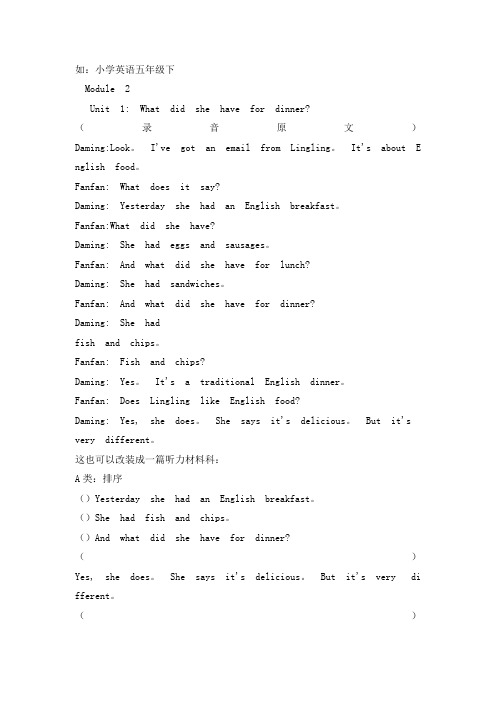
如:小学英语五年级下Module 2Unit 1: What did she have for dinner?(录音原文)Daming:Look。
I've got an email from Lingling。
It's about E nglish food。
Fanfan: What does it say?Daming: Yesterday she had an English breakfast。
Fanfan:What did she have?Daming: She had eggs and sausages。
Fanfan: And what did she have for lunch?Daming: She had sandwiches。
Fanfan: And what did she have for dinner?Daming: She hadfish and chips。
Fanfan: Fish and chips?Daming: Yes。
It's a traditional English dinner。
Fanfan: Does Lingling like English food?Daming: Yes, she does。
She says it's delicious。
But it's very different。
这也可以改装成一篇听力材料科:A类:排序()Yesterday she had an English breakfast。
()She had fish and chips。
()And what did she have for dinner?()Yes, she does。
She says it's delicious。
But it's very di fferent。
()Look。
I've got an email from Lingling。
- 1、下载文档前请自行甄别文档内容的完整性,平台不提供额外的编辑、内容补充、找答案等附加服务。
- 2、"仅部分预览"的文档,不可在线预览部分如存在完整性等问题,可反馈申请退款(可完整预览的文档不适用该条件!)。
- 3、如文档侵犯您的权益,请联系客服反馈,我们会尽快为您处理(人工客服工作时间:9:00-18:30)。
Grasp the special question
课时安排
Two
教学准备
PPT card
教与学互动设计
Step 1warming—up
Let’s have a topic about [food]
(1)Match game about compare Chinese food or English food.
What did you have for breakfast/ lunch/ dinner?
I had sausage/ sandwich/ fish and chips.
教学反思及对策
(2) Write the new words. (5words)
(3) Draw a picture about your meals: (some Ss had better write the sentences
二次备课与外延
板书设计
Modu?
(2) T: Do you know any traditional food inEngland? Yesterday our friend Lingling had a lot of English food, let’s see what are they?
Step 3Practice ( ask and answer in small group)
(2) Listen and repeat then T will explain some words and important sentences for Ss.
(3) Complete the form.
MENU
breakfast
Lunch
Supper
Step 5Homework
(1) Listen and read the text 3 times.
能力目标
Be able to ask and answer three meals and describe the time of three meals.
德育目标
Know the name of English traditional food.
教学重点
The simple past tense
课题
Module 2 Unit 1What did she have for lunch?
授课时间
知识目标
Grasp the words sausages, sandwich, and chicken and so on. And the sentence pattern“what did she have?””she had eggs and sausages”
(1) What did she have for breakfast?
She had eggs and sausages.
(2) What did she have for dinner?
She had fish and chips.
Step 4Listen and Read.
(1) Listen to the cassette and point.
(2) Show PPT about some foods and to review the words:(breakfast,lunch,dinner,egg,sausage,sandwich,fish, chip…)
Step 2Presentation
(1) Before the lesson T will ask the Ss:“What’s your favorite food?”In this part Ss should try to remember the foods word. Let’s compete in each group.
